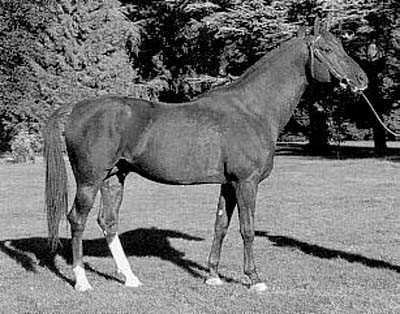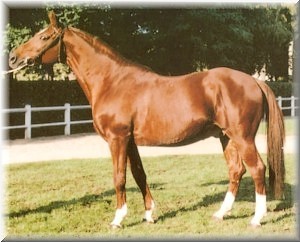Not an Arabian horse — Flipper
The French “Arabian” stallion Flipper, photo below, is representative of ‘midnight breedings’, a practice which saw some (just some) greedy French breeders of the 1970s and 1980s breed their Arabian mares to English Thoroughbred or Anglo-Arab stallions, and register their offspring as Arabians. On paper, Flipper is by Gosse du Bearn out of Fleur d’Avril. In reality, only God and his breeder know who his sire was.
People who defend horses such as Flipper will tell you that French Arabians were bred with a focus on speed, not on classic Arabian type, over a ten to fifteen generations, which is why they look the way they do. It’s true, and there was no shortage of ‘untypey’ French Arabians since the 1910s; yet, as far from classical type as they may have been, they were of authentic Arab blood. Flipper belongs to a different league: he has non-Arabian blood in his veins — and more than a trickle.
So do his sons Dunixi and Tidjani (photos below), both of whom are major progenitor of French racing lines. The status of Flipper’s line as ‘purebred’ Arabian is safely guaranteed by the presence by a senior staff of the French National Haras on WAHO’s Board of Directors.



Edouard the dead give away is his conformation. Like a lot of Angloarabians his cannons are way too small for his body size. You can see the same effect in a lot of arabian crosses that contain significant amounts of Thoroughbred. It is especially so in many Quarabs- Quarter horses blended with Arabs. The Quarter horse of course has been top crossed with thoroughbreds a great deal indeed. The results are huge 1100 and 1250 pound bodies mounted on 7 and five eights inch cannons. Give me a horse thats not more than 15.1, if not an Asil, then at least predominantly Arabian in blood. Such a horse would be able to live on grass, have few if any leg faults, weigh maybe 1020 lbs, and because his legs arent’t sore and his feet don’t hurt from supporting 25% more weight than he should be carrying, he’ll probably have a good disposition too, along with the legendary staying and recovery power of the Arab. Ask your neighbors who maye be breeding bazillion dollar warmbloods how many of their horses can match those criteria.
Best Wishes
Bruce Peek
Flipper’s sire Gosse du Bearn could be the missing link:
“la classe de Gosse du Béarn est incontestable. Il remportera toutes les courses réservées aux Arabes excepté à Villeneuve de Marsan où il cédera la victoire à Méton d’une tête. Confronté à l’Anglo, il décrochera une méritoire 2ème place à une longueur de Florelle II issue elle aussi de Djerba-Oua, dans le Prix du Désert à Biarritz”
Florelle II (was an Anglo Arab born 1954 by Djerba Oua x Flore
Moreover look at “Gosse d’Avril’ picture ,Flipper full brother.
http://www.sporthorse-data.com
One should remember that Gosse du Bearn and his uterine brother Saint Laurent are the sons of “Madou” 1.40mt(all breed pedigree) it could be that Madou was covered by 2 anglo -arabs.
Saint Laurent :Baroud II x Madou.
About his sire Baroud II(in French I’ sorry).
En 1941 la note du registre matricule du Haras National de Pau décrit Baroud II comme ’’Un peu brassicourt, expressif de la tête…’’ ’’Il a du chef, un joli tissu et une bonne expression de sang. Dans l’ensemble, il est un peu efféminé ’’ .
En fait, il n’y a pas de précisions sur sa production et si sa côte était effectivement bonne, hormis St Laurent il n’aura pas engendré d’autres performers. La demande chuta brutalement dans l’immédiat après-guerre et en se reportant à la rubrique Service de la Monte du Registre Matricule pour l’année 1947, on peut lire une jument saillie ! et production obtenue : 1 mâle : Saint-Laurent donc.
A la fin de l’hiver 1948, Mr J.Pinsolle achète St-Laurent. Déja d’un modèle hors norme (voir photo), dont on ne peut pas dire qu’il ait hérité du coté efféminé de son père.”
If Saint laurent did not inherit of his father “effeminated” characters so from where did he got his “Arab” type?Remember
Baroud was mainly used to produce Anglo Arabs ;his two Arabs were Saint laurent and Farceuse who produced mainly Anglo Arabs.
All Madou’s informations are taken from:
http://www.lozanne-publications.org/elevage/madou.
2 the Poles also had a racing tradition since 1927 still the racing Polish is a very “Arab type” horse.
The Gulf Sheiks nreponse to the French Arabs racing supremacy was: Amer and Tuwaik ,but this is another story
One other thing; Edouard I admire your guts in calling out these partbred Arabs for what they are! If only there were people of similar fortitude and knowledge in the U.S.
If anyone knows about the genetic testing angle of this whole-“sneaking partbreds into the purebred gene pool”- subject it would be good to hear from them about it. I wonder if we can look forward to the day when a prospective buyer, or for that matter a show steward or horse trials technical delegate could compare a genetic readout from a hair sample with those from known Thoroughbreds and say to the decietful competitor something like,” load your poorly disguised Anglo-Arab back in the trailer and go home because you have cheated, and I have caught you at it. Your name and a factual account of this incident will be posted on line and in the Chronicle of the Horse. Now go!”
Best wishes
Bruce Peek
I own the grand-daughter of Flipper (daughter of Tidjani) she is much like her ancestors in her size, and is very often mistaken for an Anglo Arab she’s 15,3hh and does not have the classic defined Arabian features. There is so much in her that points towards an Anglo Arab, even though both her parents were Arabians.
It’s funny to read that kind of stuff on internet: people creating stories around horses they just never saw and trying to imagine how things appened.
Dear Edouard this sentence is full of non-senses:
“The French “Arabian” stallion Flipper, photo below, is representative of ‘midnight breedings’, a practice which saw some (just some) greedy French breeders of the 1970s and 1980s breed their Arabian mares to English Thoroughbred or Anglo-Arab stallions, and register their offspring as Arabians.”
What a cultural lack.
In 70’s and 80’s cheating was close to have disappeared.
Flipper was a cheated one but the shame is that you write untrue things on the internet.
When you don’t know the real story it’s better to keep your creativity for yourself.
What is funny is that cheating was also practiced in North America, Poland and even Arabian Countries.
Dear Sir,
The story of Flipper was told to me by one of your fellow representatives of the French lobby. I don’t want to betray the trust which that person put in me.
You find it funny that people tell stories about horses they never saw; I find it funnier that people don’t tell stories about horses they saw. That’s the cultural lack (la culture du secret).
Of course the cheating happened in North America, and Poland and Arabian Countries: Amer and Tiwaiq is major cheating.
Dear William
Quoting part of your post above.
“Flipper was a cheated one but the shame is that you write untrue things on the internet.
When you don’t know the real story it’s better to keep your creativity for yourself”
Please do inform us what are the “Untrue things” that Edouard wrote.
Moreover if you “know the real story” kindly do inform us about it.I’m sure thatthe “real story” will be very useful to all our friends in the blog.
Moreover please read carefully what Emily wrote above.
“Emily Said:
September 2nd, 2010 3:50 pm
I own the grand-daughter of Flipper (daughter of Tidjani) she is much like her ancestors in her size, and is very often mistaken for an Anglo Arab”
As it seems that you are an “expert” in French Arab horses ,in your opinion from which ancestor do you think this mare brought this “Anglo Arab” look?
thank you for informing us.
Has something happened in racing?
First I noticed an organization for heritage racing (pure bred Arabians excluding the suspected french anglo’s) now I see on the site of Alawal stud (UAE racing stud) that they indicate Flipper as thoroughbred in their pedigrees instead of arab (yet Calin du Loup itself is still indicated as arab)
For Manganate & Djelfor neither is indicated …?!
It does seems to be deliberate and not error …
http://www.alawalstud.com/horses.html
http://www.alawalstud.com/calin-du-loup-horses-details-30237.html
http://www.alawalstud.com/th-richie-horses-details-30248.html
Dr. Cothran told me years ago, when he was only working with blood and not the more extensive DNA work that has occurred in more recent years, that about half the thoroughbreds have a specific blood marker that will only show up in thoroughbred… and their subsequent progeny if they have the marker. I am quite sure DNA testing today could tell us who is who, and what is what, but it is not easy to get hair pulled from some of those horses and their progeny… ie Tiwaiq and Amer. I only just came across this blog…. sorry , all old news now. ; ))
Edie, there may or may not be breed specific markers but they are not going to be universal (note that your source says “about half”) and in the event of what the genealogists call a non-parental event they certainly will not be transmitted to all the progeny, and they certainly will not be transmitted uniformly in subsequent generations.
In other words, assuming for sake of argument there is a marker, it can’t be detected in all descendants, any more than all Skowronek’s descendants have the grey G allele at the G locus (and he was actually homozygous for that).
I have been reading your wonderful blog a lot lately Edouard. But regarding this thread, I would respectfully disagree with M. Bowling and agree with Edie. See: https://www.ncbi.nlm.nih.gov/pmc/articles/PMC3616054/ And how a genetic variation of Y chromosome was tracked to the English Thoroughbred sire Whalebone (HT3). Indeed it does only provide linkage to about half of the Darley Arabian male descent. However, if the sire line of any stallion used for breeding is still alive today, it might be tested for HT3 variation (or better the lack of it regarding the registered Arabian horses). Maybe Whalebone’s descent was never used for “Midnight breeding” but if it was it can be tracked this way. I really do hope there is no Whalebone’s sire line within the Arabian breed cause it would be a great shame! Of course, it can’t help for mid-pedigree ancestors but at least this is a very reasonable start if anybody is willing to check a non Thoroughbred sire line. Most definitely think there could not be any possible HT4 (Icelandic) HT5 (Shetland pony) or HT6 (Norwegian Fjord) within our breed 😮 !! But who knows?? One would also notice that most of the Desertbred, Egyptian, Syrian and Iraqi ancestors (including Kuhaylan Haifi, Ilderim, Ibrahim, Kuhailan Zaid and Siglavy) belong to HT1 while Godlophin Arabian, Byerley Turk & Darley Arabian, Bairactar, Gazlan and a couple of others belong to HT2. I think one should not jump to conclusions hastily about those two since this is just a couple of Arabian sire lines tested, although some of those are very important “Westerners” ones.
Well I had my Arabian mare’s DNA tested since she has Flipper in her pedigree and guess what? No other breed showed up. So please stop circulating rumors that descendants of Flipper are not pure. No thoroughbred showed in her DNA!
Well, that’s not dozens of other tests of Flipper horses are showing.